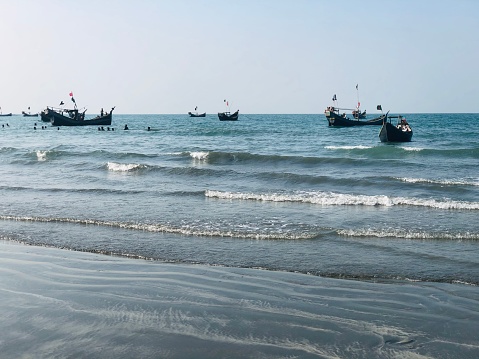Highlights
- Valuable minerals like uranium, thorium, and heavy sands found in Bangladesh’s sea territory
- Experts estimate $250 billion (USD) can be extracted annually from the Bay of Bengal
- Currently, Bangladesh utilizes only $9.6 billion worth of marine resources
- Discovery of over 200 species of seaweed, 347 types of fish, and 498 shell species
- Government working on short-, mid-, and long-term Blue Economy plans
- Prof. Muhammad Yunus emphasizes sustainable use of coastal resources
Massive Resources Found Beneath the Bay of Bengal
Bangladesh’s sea area is rich with trillions of dollars worth of minerals, including uranium and thorium, according to experts. In the shallow waters, a large amount of clay, used for cement production, has also been discovered. Researchers have identified 13 locations containing ilmenite, zircon, rutile, garnet, and magnetite, along with large gas reserves.
Experts estimate that $250 billion (USD) worth of resources could be extracted annually from the Bay of Bengal. However, due to limited initiatives, Bangladesh is currently harvesting only $9.6 billion worth.
Rich Potential of Marine Minerals
Specialists say the seabed holds a variety of non-living resources such as oil, gas, limestone, and 17 types of mineral sands. These include ilmenite, zircon, rutile, garnet, magnetite, and monazite, all of which are highly valuable. Processing these materials could produce lead, zinc, copper, cobalt, and molybdenum, used in aircraft, chemical industries, and factories.
“Short-term Profit নয়, Long-term Growth-ই আসল।”
Global and National Significance
Globally, the sea contributes $3–5 trillion annually to economic activities. Around 15% of the world’s protein comes from marine life, and 30% of global oil and gas comes from beneath the ocean floor. Experts believe that as the global population nears 9 billion by 2050, oceans will play a vital role in meeting food and energy needs.
For Bangladesh, the Blue Economy could create millions of jobs and significantly strengthen the national economy. Yet, ocean resources currently account for only 6% of the GDP.
Government Plans to Develop the Blue Economy
Following the 2014 maritime boundary victory, Bangladesh created short-, mid-, and long-term plans aligned with the UN SDGs (2018–2030).
- Short-term: Identifying marine fish stocks and fishing zones
- Mid-term: Controlling illegal fishing, improving fishermen’s livelihoods, and protecting biodiversity
- Long-term: Building databases, developing mariculture, and advancing coastal aquaculture
“Grow smarter, not harder —
ঝামেলামুক্ত অনলাইন ব্যবসার শুরু করুন Storola দিয়ে “
Recent Scientific Findings
Recent joint research with the UK and the Netherlands revealed that Bangladesh’s sea territory contains:
- 220 species of seaweed
- 347 species of marine fish
- 498 species of shellfish
- 52 types of shrimp
- 61 types of seagrasses
These findings will help create policies for marine conservation, sustainable harvesting, and climate adaptation.
Voices from Experts and Leaders
Muhammad Yunus said,
“বঙ্গোপসাগরের একটা অংশও আমাদের দেশ। এর পরিমাণ মোট জমির পরিমাণের চাইতে বেশি। বঙ্গোপসাগর আমাদের দেশের মূল্যবান অংশ, এ কথা সবসময় মাথায় রেখে অগ্রসর হব।”
Translation: “The Bay of Bengal is a valuable part of our nation, even larger than our land territory. We must move forward keeping that in mind.”
Read More: Israeli Soldier Accidentally Killed by Friend’s Gun
Nadia Islam Nadi said:
“এসব মূল্যবান সম্পদ সঠিক উপায়ে উত্তোলন করতে পারলে হাজার কোটি টাকার বৈদেশিক মুদ্রা আয় করা সম্ভব।”
Translation: “If extracted properly, these resources could bring billions in foreign exchange.”
Dr. Musleh Uddin said:
“ব্লু ইকোনমিকে সমৃদ্ধ করা গেলে বাংলাদেশের অর্থনীতিতে গুরুত্বপূর্ণ ভূমিকা রাখবে। এর জন্য পরিকল্পনার পাশাপাশি আধুনিক প্রযুক্তিও যুক্ত করতে হবে।”
Translation: “Strengthening the Blue Economy can play a major role in Bangladesh’s economy, but modern technology must be incorporated.”
The Road Ahead
Experts stress that pollution control, sustainable management, and international cooperation are key to unlocking the Bay’s potential. If Bangladesh can properly plan and implement strategies, the Bay of Bengal could become not just the engine of the national economy, but a legacy of prosperity for future generations.


















